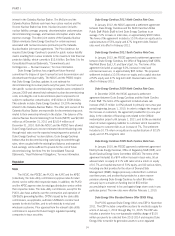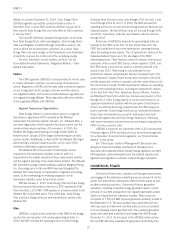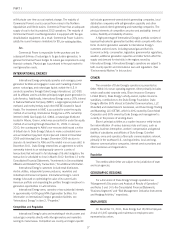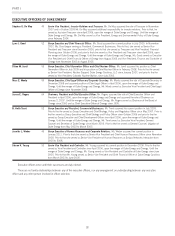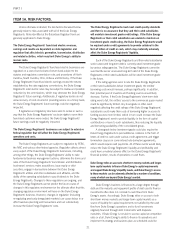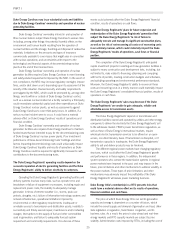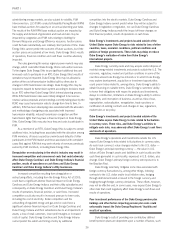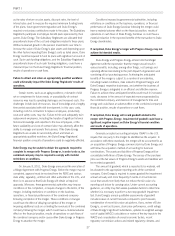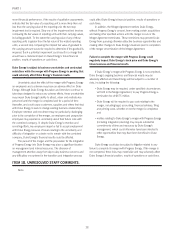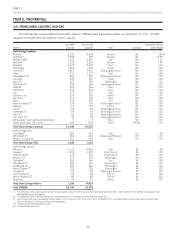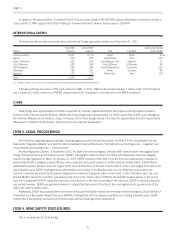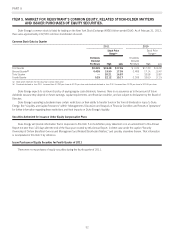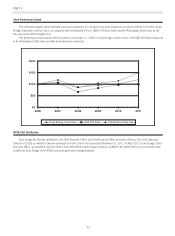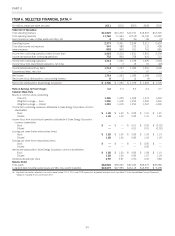Duke Energy 2011 Annual Report Download - page 44
Download and view the complete annual report
Please find page 44 of the 2011 Duke Energy annual report below. You can navigate through the pages in the report by either clicking on the pages listed below, or by using the keyword search tool below to find specific information within the annual report.
PART I
• supply of and demand for energy commodities;
• transmission or transportation constraints or inefficiencies
which impact the Duke Energy Registrants’ non-regulated
energy operations;
• availability of competitively priced alternative energy sources,
which are preferred by some customers over electricity
produced from coal, nuclear or gas plants, and of energy-
efficient equipment which reduces energy demand;
• natural gas, crude oil and refined products production levels
and prices;
• ability to procure satisfactory levels of inventory, such as coal
and uranium;
• electric generation capacity surpluses which cause the Duke
Energy Registrants’ non-regulated energy plants to generate
and sell less electricity at lower prices and may cause some
plants to become non-economical to operate; and
• capacity and transmission service into, or out of, the Duke
Energy Registrants’ markets.
Coal inventory levels have increased due to mild weather, low
natural gas and power prices resulting in higher combined cycle
gas-fired generation, and the economy’s overall effect on load.
Continuation of these factors for an extended period of time, could
result in additional costs of managing the coal inventory such as
purchased power or other costs. If these costs are not recoverable the
Duke Energy Registrants results of operations could be negatively
impacted.
Energy conservation could negatively impact the Duke Energy
Registrants’ financial results.
Certain regulatory and legislative bodies have introduced or are
considering requirements and/or incentives to reduce energy
consumption by certain dates. Additionally, technological advances
driven by federal laws mandating new levels of energy efficiency in
end-use electric devices or other improvements in or applications of
technology could lead to declines in per capita energy consumption.
To the extent conservation results in reduced energy demand or
significantly slows the growth in demand, the Duke Energy
Registrants’ unregulated business activities could be adversely
impacted. In the Duke Energy Registrants’ regulated operations,
conservation could have a negative impact depending on the
regulatory treatment of the associated impacts. The Duke Energy
Registrants currently have energy efficiency riders in place to recover
the cost of energy efficiency programs in North Carolina, South
Carolina, Ohio and Kentucky. Should the Duke Energy Registrants be
required to invest in conservation measures that result in reduced
sales from effective conservation, regulatory lag in adjusting rates for
the impact of these measures could have a negative financial impact.
The Duke Energy Registrants’ operating results may fluctuate on a
seasonal and quarterly basis.
Electric power generation is generally a seasonal business. In
most parts of the U.S., and other markets in which the Duke Energy
Registrants operate, demand for power peaks during the warmer
summer months, with market prices typically peaking at that time. In
other areas, demand for power peaks during the winter. Further,
extreme weather conditions such as heat waves or winter storms
could cause these seasonal fluctuations to be more pronounced. As a
result, in the future, the overall operating results of the Duke Energy
Registrants’ businesses may fluctuate substantially on a seasonal and
quarterly basis and thus make period comparison less relevant.
Potential terrorist activities or military or other actions, including
cyber system attacks, could adversely affect the Duke Energy
Registrants’ businesses.
The continued threat of terrorism and the impact of retaliatory
military and other action by the U.S. and its allies may lead to
increased political, economic and financial market instability and
volatility in prices for natural gas and oil which may materially
adversely affect the Duke Energy Registrants in ways the Duke
Energy Registrants cannot predict at this time. In addition, future acts
of terrorism and any possible reprisals as a consequence of action by
the U.S. and its allies could be directed against companies operating
in the U.S. or their international affiliates. Cyber systems,
infrastructure and generation facilities such as the Duke Energy
Registrants’ nuclear plants could be potential targets of terrorist
activities or harmful activities by individuals or groups. The potential
for terrorism has subjected the Duke Energy Registrants’ operations to
increased risks and could have a material adverse effect on the Duke
Energy Registrants’ businesses. In particular, the Duke Energy
Registrants may experience increased capital and operating costs to
implement increased security for its cyber systems and plants,
including its nuclear power plants under the NRC’s design basis
threat requirements, such as additional physical plant security,
additional security personnel or additional capability following a
terrorist incident.
The insurance industry has also been disrupted by these
potential events. As a result, the availability of insurance covering
risks the Duke Energy Registrants and the Duke Energy Registrants’
competitors typically insure against may decrease. In addition, the
insurance the Duke Energy Registrants are able to obtain may have
higher deductibles, higher premiums, lower coverage limits and more
restrictive policy terms.
Additional risks and uncertainties not currently known to the
Duke Energy Registrants or that the Duke Energy Registrants
currently deems to be immaterial also may materially adversely affect
the Duke Energy Registrants’ financial condition, results of operations
or cash flows.
24


